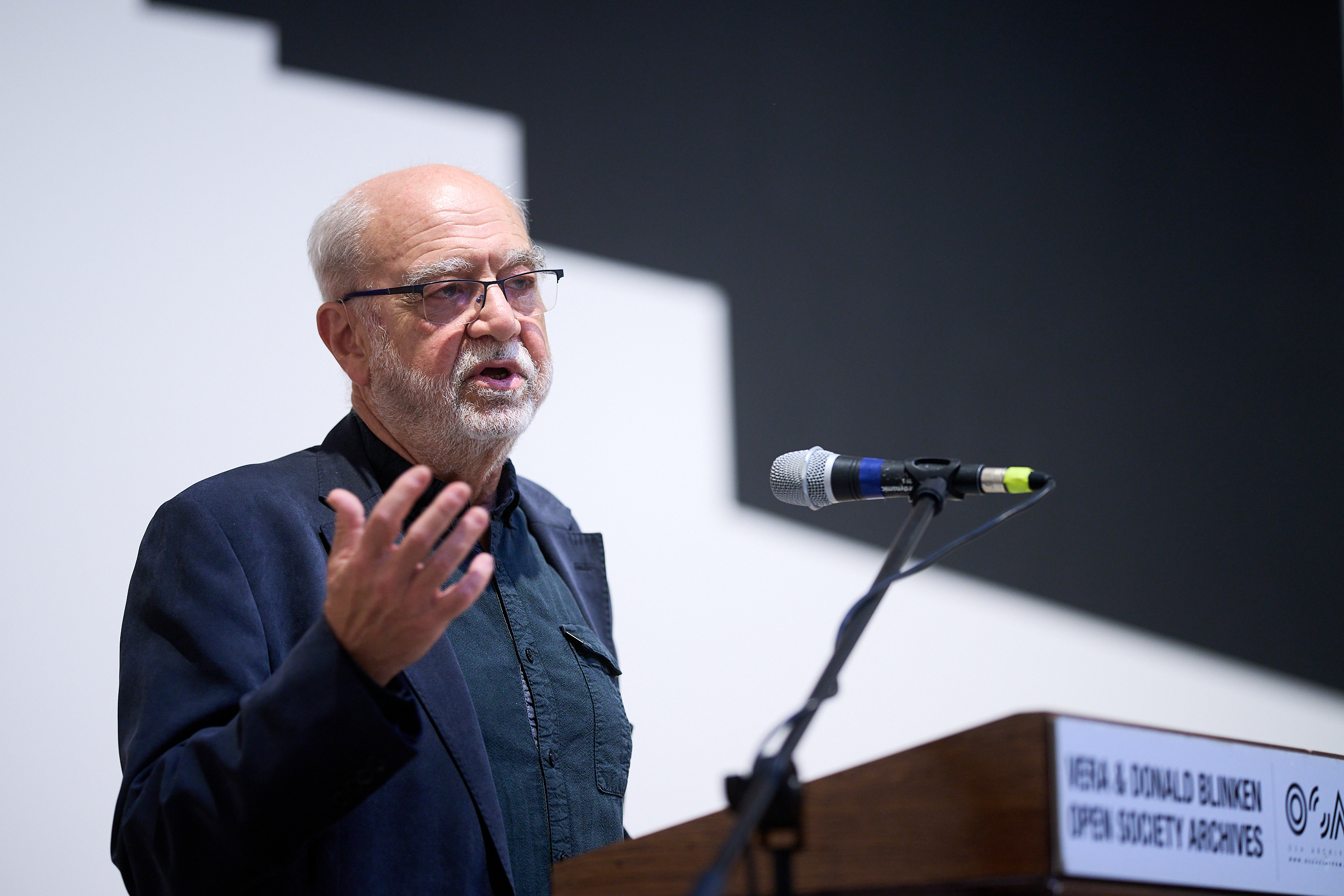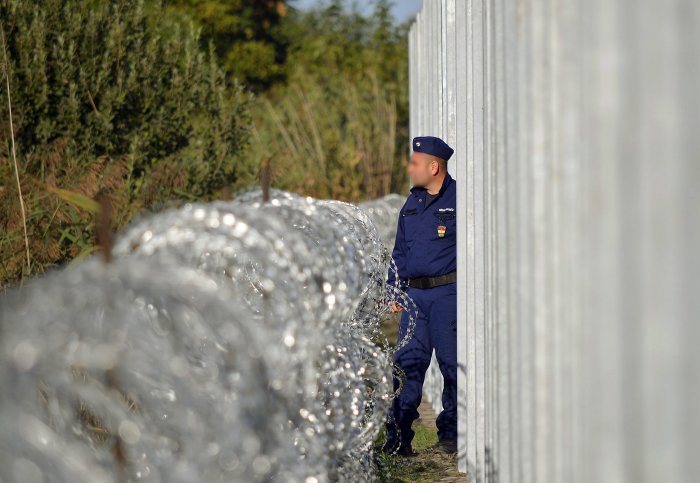Artists Beating Around the Brush: Art, Politics and the Holocaust in 1960s Hungary

“A Man with A Yellow Star” by Endre Szász
Veteran economic journalist Kester Eddy went along to the opening of “Commissioned Memory: Hungarian Exhibitions in Auschwitz, 1960-1965” at the Galeria Centralis, unsure of what he would find.
I must admit that the invitation to the opening of this exhibition had me somewhat befuddled. En route to the event, I wondered what it was all about Paintings, probably, yes, but of what?
I imagined scenes on canvas similar to the many photographs of vacant-eyed, starving inmates in striped clothing and bearing yellow stars, all surrounded by electrified fences, with dogs straining on leashes held by the ubiquitous, brooding SS troops. And, of course, wooden towers, with ever-vigilant guards ready to spray bullets into any tormented soul who might run to the fence, hoping, in whichever way, to escape this living horror.
But apart from a general theme of misery and brutality, most works depicted in “Commissioned Memory” have little of this, at least not overtly. In fact, for the most part, the pieces could commemorate victims of the Soviet Gulag or any of a score of repressive left- or right-wing dictatorships throughout the last century.
Only one piece, “Deportation,” the first in the collection, illustrates clear links to the Nazi Holocaust and the death camps. (And, in this work, the links are certainly “in your face,” the unknown artist spells it out, literally, with the names of the death camps, just in case you don’t get it.)
But with a swift tour of the rooms and reading the accompanying explanations (in English and Hungarian), things began to fall into place. Subsequently, the opening address by Professor András Kovács of the CEU Jewish Studies Program and a talk with curator Daniel Véri, from the Central European Research Institute for Art History put the whole conundrum in context.
This is not an easy matter because, despite its title and outward appearance, at its very core, this show is not about Auschwitz nor even the Jewish Holocaust in general. But let us start at the beginning, and with the simple, important news: the bulk of the works on show were packed away in 1979 and forgotten. None have ever been exhibited previously in Hungary, their country of origin.

Daniel Véri
National Experiences
In 1960, 15 years after the Red Army liberated Auschwitz, the Polish Museum at the site offered space in the former barrack blocks for nations to mount exhibits and memorialize their own experiences of the Nazi killing machine.
Hungary, which deported an estimated 437,000 of its Jewish citizens, and Czechoslovakia were the first to take up the opportunity, although the aforementioned “Deportation” is the only work from the 1960 event in the offering today.
In 1965, the Hungarian authorities had another, much more extensive stab at the job, commissioning works from 10 different artists for another exhibition, which ran for 14 years in Auschwitz. On their return home, these pieces were placed in store at a museum in Szombathely, western Hungary. Recently rediscovered, they make up the bulk of the current show.
So far, so straightforward, you might think. Except, as the descriptive texts placed around the exhibition explain, not a single one of the commissioned artists, at least as far as is known, was Jewish or had any experience of the Nazi camps, despite the thousands of Hungarian Holocaust survivors, including talented artists, alive at the time.
Moreover, only one exhibited piece demonstrates but the faintest association with the Holocaust’s principal victims: “A Man with a Yellow Star,” a painting by Endre Szász, is just about worthy of its title, its gaunt, long-nosed figure sporting a barely visible six-pointed star on his chest.
What on earth were these artists up to? Why the prevarication? Why, you might ask, were these artists so diligently, so bizarrely, beating around the brush? The answer to this enigma lies in the historical events and politics of the time, Kovács argued in his address at the exhibition’s opening.
In 1960, Mossad agents kidnapped Adolf Eichmann, a key architect of the Holocaust, and smuggled him to Israel to stand trial for war crimes. It was a global sensation that the Hungarian government could not ignore. Eichmann, after all, had overseen the deportations in Hungary in 1944.

András Kovács
Party Line
But in Budapest, the communist government, kept in power with the backing of Soviet tanks in 1956, was desperate for legitimacy at home while needing to move in step with Moscow’s pro-Arab line on the international stage. At a Central Committee meeting called to discuss the issue, János Kádár, general secretary and de facto communist leader, laid out the party line. Kovács read out parts of Kádár’s address to that meeting.
“It is not good [policy] to make these miserable fascist issues exclusively a Jewish question,” Kádár intoned. “The determining point should be that Eichmann did this to thousands of Hungarian citizens.”
In other words, Kádár, in his Orwellian logic, was saying, “All Hungarians suffered.” And, just in case his listeners hadn’t got the message, he concluded: “It isn’t a Jewish question; it’s a fascist and anti-fascist question: About the Jews, that’s enough.”
With more than 400 executions for anti-state crimes since the 1956 revolution still very fresh in the public memory, and hundreds, possibly thousands of political prisoners still languishing in Hungarian jails, given such political direction, it’s little wonder that those artists commissioned to create the Auschwitz exhibition pieces proceeded with caution.
Indeed, Endre Szász, by even alluding to the Jewish connection in “A Man with a Yellow Star,” may have been putting his career, even his freedom, on the line. As Kovács put it, the communist leadership of the 1960s created a plan, a process, to mold the public memory of the Hungarian Holocaust to somehow deal with the difficulties it raised in society and to give the regime itself legitimacy.
The object of the exhibition today, he said, is “to process the processing of the past.”
That’s a mighty tall order, but this show at least makes a start. My only concern is that, lacking Kovács’ insights and hand-holding, many may be unable to take up the opportunity offered to those at the opening.
“Commissioned Memory: Hungarian Exhibitions in Auschwitz, 1960/1965,” comprises 22 images (a mix of paintings, drawings and etchings), two sculptures, and one object, an urn. It runs from Sep. 14-Dec. 3, 2023, in the Blinken Open Society Archives, Galeria Centralis, Arany János utca 32, 1051 Budapest. Hours: Tuesday-Sunday: 10 a.m.-6 p.m. (Closed during the Verzió Film Festival, Nov. 23-25.)
This article was first published in the Budapest Business Journal print issue of September 22, 2023.
SUPPORT THE BUDAPEST BUSINESS JOURNAL
Producing journalism that is worthy of the name is a costly business. For 27 years, the publishers, editors and reporters of the Budapest Business Journal have striven to bring you business news that works, information that you can trust, that is factual, accurate and presented without fear or favor.
Newspaper organizations across the globe have struggled to find a business model that allows them to continue to excel, without compromising their ability to perform. Most recently, some have experimented with the idea of involving their most important stakeholders, their readers.
We would like to offer that same opportunity to our readers. We would like to invite you to help us deliver the quality business journalism you require. Hit our Support the BBJ button and you can choose the how much and how often you send us your contributions.


.png)







.png)
